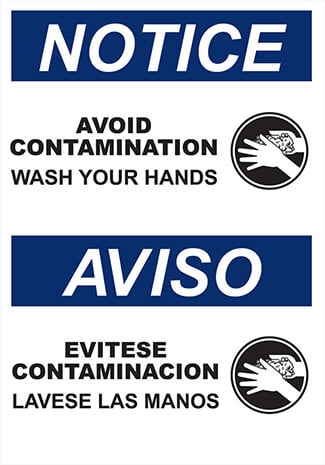7 Tips for Safety Signs Workers Will Read

There's no question that safety signs in the workplace have value. True, they are a general industry compliance requirement by the Occupational Safety & Health Administration. However, there is something else equally important: effectiveness. When value combines with efficiency, the results are messages that stick with employees to improve behavior and ingrain into a company's business culture. Amplifying the effectiveness of signs and labels starts in the creation process and sustains on through holding employee attention.
Memorable Messages
 OSHA 29 CFR 1910.145 requires consistent safety signs in the workplace. However, there are also psychological mechanisms in signs that help prompt changes in behavior, according to the National Center for Biotechnology Information. From arc flash warnings to wayfinding, getting the team to read and apply informative messages should be easy by following key methods for thoughtful design. After all, according to numerous experts and studies, people are highly likely to retain visual cues. Here are seven ways to share updates, ideas, and information that coworkers will read and remember.
OSHA 29 CFR 1910.145 requires consistent safety signs in the workplace. However, there are also psychological mechanisms in signs that help prompt changes in behavior, according to the National Center for Biotechnology Information. From arc flash warnings to wayfinding, getting the team to read and apply informative messages should be easy by following key methods for thoughtful design. After all, according to numerous experts and studies, people are highly likely to retain visual cues. Here are seven ways to share updates, ideas, and information that coworkers will read and remember.
- Keep it short and sweet: Long messages turn off readers, especially when there's work to be done. Use succinct, bite-size communication so workers can read a message quickly and move on. The most important information should be first. Anything secondary can be part of ongoing safety discussions or toolbox talks with safety managers.
- Picture it: Increase engagement and support a workplace message with an image on signs for safety. Demonstrate proper techniques by using photos or other imagery such as shapes or symbols. The right colors can also help catch an employee's eye to quickly determine the type of hazard present in any work situation.
- Know the audience: An age-diverse workforce is also a skills-diverse workforce. Try using different words so messages resonate and stand out. Capitalize, bold, use punctuation, various text sizes, and personalize messages when appropriate. Be sure the message is clear, clean, and understandable.
- Placement: Location, location, location ? know where a sign or label can make the most impact on a worker. A sign that is too high or a foot too far from the work area won't do. Evaluate logical positions for messages that can be seen at typical worker eye levels. Don't forget the value in creating visual boundaries, adding additional messages, and reinforcing safety using floor marking and wayfinding.
- Keep it real: Speak human. Real, natural language is easier to read and remember. Be authentic and relatable with safety messages and writing. Want to hone in on humor? Introduce serious messages in a tastefully light way. This can help make information easier to absorb.
- Use the right materials: Not all sign and label materials work the same. It is imperative to use durable materials that can hold up in harsh environments, physically demanding tasks or equipment, and cleaning products. Choose from stock that is easily noticeable in low-light situations, repositionable in changing workspaces, or even metal detectable label materials.
- Change it up: Custom create messages and swap out signs periodically. This will help keep messages fresh and keep workers' attention. Need more inspiration? Use a facility visual communication checklist.
Effective Communication
The future of business includes keeping workers informed, protected, and motivated. Businesses will enjoy immeasurable benefits to efficiency and low downtime by making an effort to invest in improving visual communication. Workplaces can print their messages or order preprinted visuals to address hazards, comply with mandatory protocol, and provide workers with informative reminders. Facility managers can keep workplace efficiency flowing by following up with engaging conversations. When equipment changes or there is a revision of work methods, be sure to talk with workers about their tasks and thoughts on procedures. Address the challenges of making workplace health and safety successful through effective leadership, consistent messaging, and safety fundamentals that last. Need more help meeting OSHA and ANSI requirements and standards? We've got you covered. Download this free resource and share it with your team: OSHA Safety Signs Best Practice Guide.
Related Resources

Five Ways to Meet OSHA Requirements for Safety Signage
Every day, American workers service high-powered equipment, build and fix roads, and manufacture the goods we ...
Read
The Overlooked Fix That Improves Electrical Panel Safety
How Do Electrical Panel Labels Improve Safety and Compliance? Electrical panels are essential to every ...
Read
Safe Distancing for Electrical Work
In a recent Facebook poll, electrical workers said that work area and arc flash boundaries were among their ...
Read.png)





